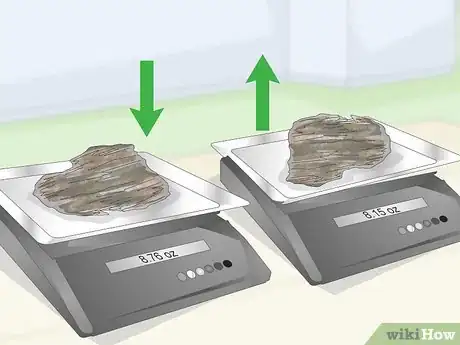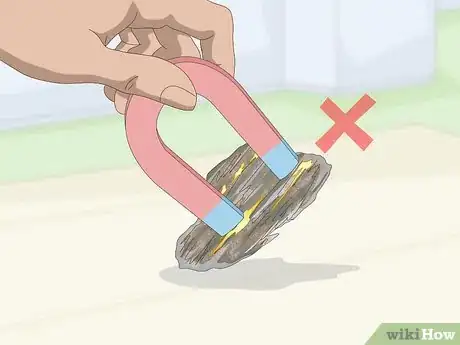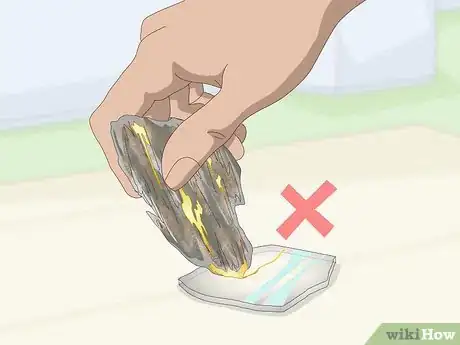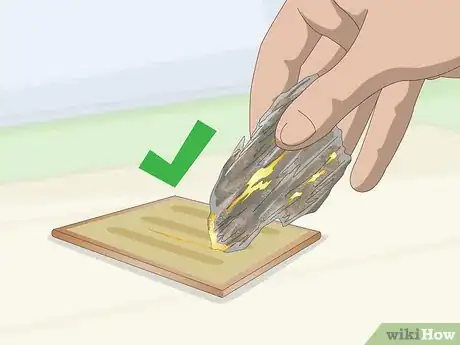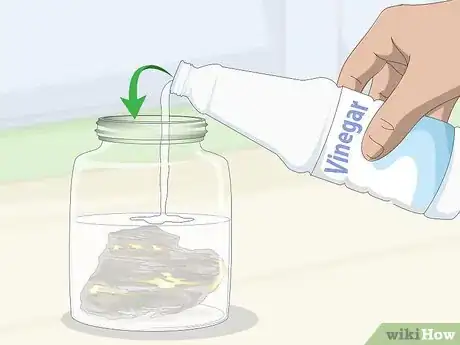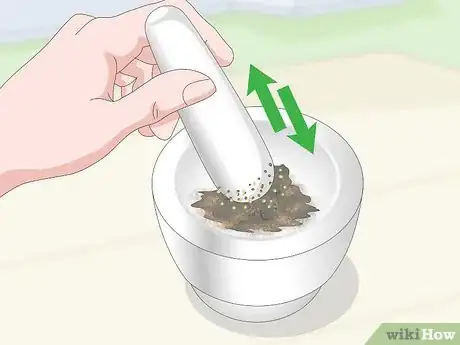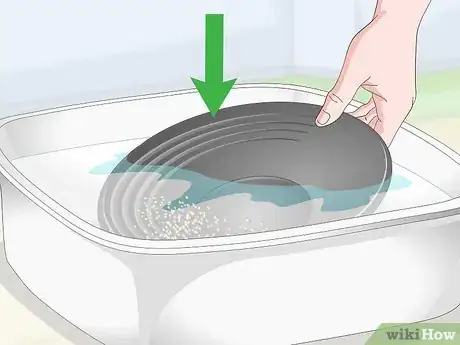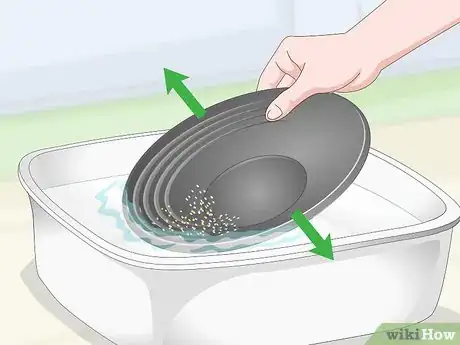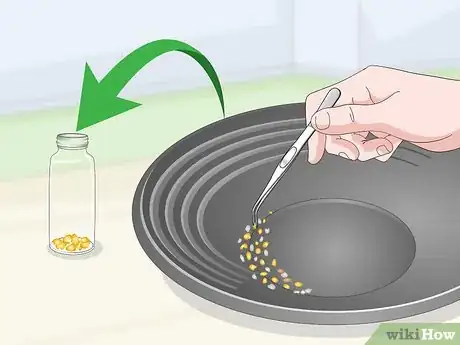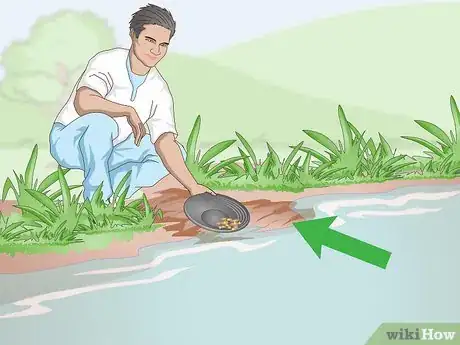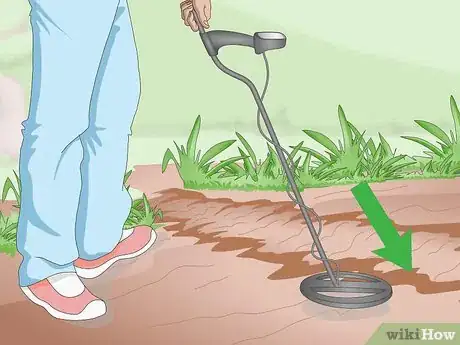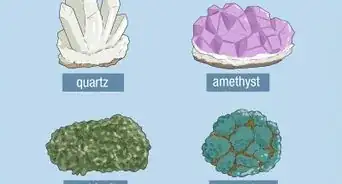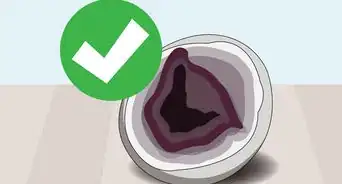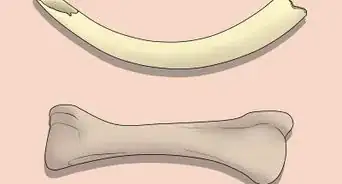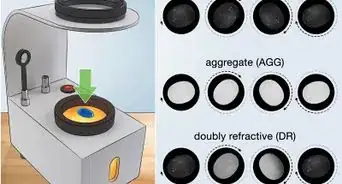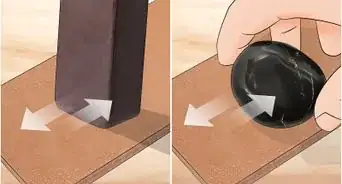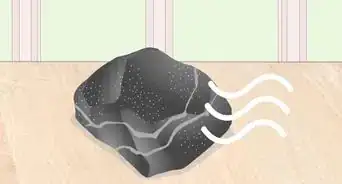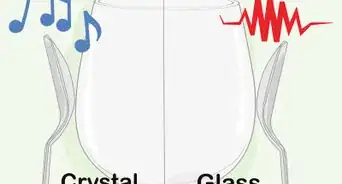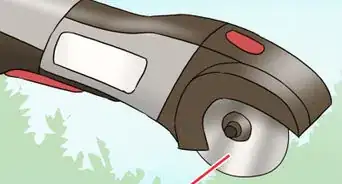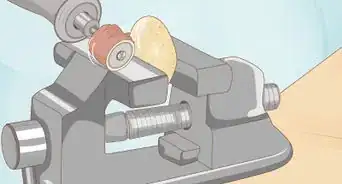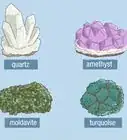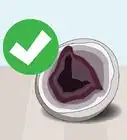This article was co-authored by Sam Lagor, MSc. Sam Lagor is a Geologist with over eight years of experience. He specializes in engineering geology (dams, bridges, and tunnels) and mineral exploration (gold, lead/zinc, andindustrial minerals). Sam holds a BS in Geology from St. Lawrence University and an MS in Geology from The University of Vermont. He is also a member of the Geological Society of America and the American Institute of Professional Geologists.
There are 7 references cited in this article, which can be found at the bottom of the page.
wikiHow marks an article as reader-approved once it receives enough positive feedback. In this case, 90% of readers who voted found the article helpful, earning it our reader-approved status.
This article has been viewed 228,065 times.
Real gold is a very rare and valuable metal. Because it's so rare, finding large pieces of gold in nature is unusual. However, you might be able to find smaller pieces of gold inside of rocks like quartz! If you have a piece of quartz and want to tell if there is real gold inside it, there are few home tests you can try before taking your rock to an assayer, who will tell you for sure what's inside your quartz and how much it's worth.
Steps
Conducting Home Gold Tests
-
1Compare weights between pieces of quartz. Real gold is very heavy. If you have a piece of quartz with pieces of what you think is gold inside it, try weighing it and compare the weight with a similarly sized piece of quartz. If the quartz with gold pieces in it weighs several grams more than a similarly sized piece of quartz, it's possible that your quartz contains real gold.[1]
- Real gold weighs about 1.5 times more than fool's gold, or iron pyrite.
- Fool's gold and other minerals that look like gold will not produce a weight difference between the pieces of quartz. In fact, the piece with gold-colored particles inside may even be lighter than your other piece of quartz if the gold is not real.
-
2Do a magnet test. Iron pyrite, most commonly referred to as “fool's gold,” is magnetic, whereas real gold is not. Hold a strong magnet up to the gold-colored material in your piece of quartz. If your rock sticks to the magnet, it is iron pyrite and not real gold.[2]
- Refrigerator magnets may not be strong enough for the gold test. Purchase a stronger magnet, or earth magnet, at a home improvement store.
Advertisement -
3Try scratching a piece of glass with the gold. Real gold will not scratch a piece of glass, but other minerals that look like gold often do. If your piece of quartz has a corner or edge that looks like gold on it, try scratching this against a piece of glass. If it leaves a scratch, it is not real gold.[3]
- You can use any piece of broken glass or mirror for this test. Just be sure to use something that you don't mind scratching.
- Real gold is extremely soft; in fact, it's soft enough that it can be turned into a foil.[4]
-
4Scratch a piece of unglazed ceramic with the gold. Real gold will leave a gold-colored streak when scratched against unglazed ceramic, such as the back of a bathroom tile. Iron pyrite leaves a greenish-black colored streak when scratched on ceramic.[5]
- Try the back of a loose bathroom or kitchen tile for this test. Most ceramic dishes are glazed, so they won't work for testing the gold.
-
5Conduct an acid test with vinegar. If you don't mind destroying the quartz, you can find out if you have gold in your quartz by doing an acid test. Place your quartz in a glass jar and cover it completely with white vinegar. The acid in the vinegar will dissolve the quartz crystals in several hours, leaving only bits of quartz attached to the gold.[6]
- Real gold will not be affected by the acid, but other gold-look alike materials will dissolve or become damaged.
- You can use more potent acids which may work faster, but these would require extra caution and safety measures. Vinegar is a safe acid to use at home.
Crushing and Panning
-
1Obtain a steel or cast-iron mortar and pestle. The best way to crush rocks at home without professional equipment is with a mortar and pestle. You want to be sure it is made of material that will be harder than the quartz and gold you're crushing, such as steel or cast iron.[7]
- The crushing and panning method will destroy your piece of quartz. Make sure you're okay with destroying your quartz before starting crushing and panning.
-
2Crush your quartz until it is a fine powder. Place your piece of quartz in the mortar, or bowl of your mortar and pestle set. Press hard on it with the pestle until pieces start to break off. Crush these smaller pieces up until you have a dust of quartz and gold mixed together.[8]
- If you end up breaking off larger pieces that are only quartz, you can separate these out and focus only on the areas that have gold-colored particles.
-
3Obtain a gold pan and submerge your powders in water. Commercially produced gold pans can be found for about $10 or less online. Take your crushed powders and mix them with water in a large tub. Then dip your gold pan into the water, trying to get as much powder into it as you can.[9]
-
4Swirl the powdery water around in your pan until the gold separates. Use a circular motion to swirl the water around in your gold pan. Real gold, because it is the heaviest, will settle down to the bottom of the pan. Other lighter particles of quartz will rise to the top.[10]
- Empty the water with lighter quartz powders into a different container by tipping the gold pan slightly and setting this aside to dispose of later.
- You may have to repeat this step multiple times to get the gold to settle at the bottom. Have patience!
- If the gold-colored dust never settles to the bottom, and instead rises to the top of the gold pan with the other quartz powder, unfortunately, it was not real gold to begin with.
-
5Remove the gold pieces with tweezers into a glass vial. After spending time sifting the powders, you may begin to see gold particles and flakes at the bottom of your pan. Remove these pieces with tweezers and place them in a glass vial to take them to an assayer to determine how much they are worth.[11]
- If you have other pieces of black sand in the bottom of your pan mixed with your gold dust, use a strong magnet to separate those out from the gold before putting the gold into a vial.
Finding Gold in Quartz in Nature
-
1Look in places where gold and quartz occur naturally. Gold usually originates upstream from where it is panned or has been panned in the past. These regions include areas where volcanic hydrothermal activity has happened in the past, near old gold mines. Quartz veins are often formed in areas where the bedrock is fractured by tectonic and volcanic activity.[12]
- Gold has been historically mined in certain areas of the U.S. west coast and Rocky Mountains, Australia, South America, and central Europe.
-
2Check the natural cracks and lines of the quartz rock. Gold often occurs along the natural linear structures of quartz rock, or its natural cracks and lines. It is easiest to spot in white quartz, though quartz can come in a range of colors including yellow, pink, purple, grey, or black.
- If you find gold in quartz in nature, use a geology hammer and sledge to break open the quartz and potential gold bearing rocks.[13]
- Be sure you have permission from the land owner to remove rocks from the property before doing this. Don't trespass on land without written permission by the owner.
-
3Use a metal detector if you have one. Larger gold pieces will give off a strong signal on a metal detector. However, getting a positive metal detector signal could indicate other metals being present besides gold. However, when there is metal found in quartz, gold is often among those that are found.[14]
- Some metal detectors have a specific gold setting, so if you're looking to buy a metal detector specifically for gold, try to find one that has this setting built in.
Expert Q&A
-
QuestionIs gold always found in quartz?
 Sam Lagor, MScSam Lagor is a Geologist with over eight years of experience. He specializes in engineering geology (dams, bridges, and tunnels) and mineral exploration (gold, lead/zinc, andindustrial minerals). Sam holds a BS in Geology from St. Lawrence University and an MS in Geology from The University of Vermont. He is also a member of the Geological Society of America and the American Institute of Professional Geologists.
Sam Lagor, MScSam Lagor is a Geologist with over eight years of experience. He specializes in engineering geology (dams, bridges, and tunnels) and mineral exploration (gold, lead/zinc, andindustrial minerals). Sam holds a BS in Geology from St. Lawrence University and an MS in Geology from The University of Vermont. He is also a member of the Geological Society of America and the American Institute of Professional Geologists.
Geologist Not at all—finding gold in quartz is incredibly rare. You should consider yourself very lucky if you find a piece of quartz with gold in it!
Not at all—finding gold in quartz is incredibly rare. You should consider yourself very lucky if you find a piece of quartz with gold in it! -
QuestionWhat looks like gold but isn't gold?
 Sam Lagor, MScSam Lagor is a Geologist with over eight years of experience. He specializes in engineering geology (dams, bridges, and tunnels) and mineral exploration (gold, lead/zinc, andindustrial minerals). Sam holds a BS in Geology from St. Lawrence University and an MS in Geology from The University of Vermont. He is also a member of the Geological Society of America and the American Institute of Professional Geologists.
Sam Lagor, MScSam Lagor is a Geologist with over eight years of experience. He specializes in engineering geology (dams, bridges, and tunnels) and mineral exploration (gold, lead/zinc, andindustrial minerals). Sam holds a BS in Geology from St. Lawrence University and an MS in Geology from The University of Vermont. He is also a member of the Geological Society of America and the American Institute of Professional Geologists.
Geologist Sulphide minerals and pyrite can sometimes be mistaken for gold. Suphide minerals are yellowish and shimmery, while pyrite is shiny and yellow. Still, these minerals all pale in comparison to pure gold, which is brilliantly golden.
Sulphide minerals and pyrite can sometimes be mistaken for gold. Suphide minerals are yellowish and shimmery, while pyrite is shiny and yellow. Still, these minerals all pale in comparison to pure gold, which is brilliantly golden. -
QuestionHow do you identify quartz?
 wikiHow Staff EditorThis answer was written by one of our trained team of researchers who validated it for accuracy and comprehensiveness.
wikiHow Staff EditorThis answer was written by one of our trained team of researchers who validated it for accuracy and comprehensiveness.
Staff Answer wikiHow Staff EditorStaff AnswerQuartz (silicone dioxide) is found in abundance around the world, being Earth’s second most common mineral after feldspar. Shape-wise, rock quartz forms crystals in hexagonal prisms with sharp ends of six-sided points looking like little pyramids; however, some quartz embedded in rock has an irregular mass, with no definite shape. Color-wise, while most quartz is colorless and transparent, it does come in a variety of colors as well, including purple, red, brown, pink, black, blue, green, etc.; the color depends on whether it's found in igneous, metamorphic or sedimentary rocks. You can test quartz: Since quartz is extremely hard (quartz has a hardness of 7 on the Mohs scale), it will be very hard to scratch if scraped with a blade, but take care not to injure yourself if you try this test.
wikiHow Staff EditorStaff AnswerQuartz (silicone dioxide) is found in abundance around the world, being Earth’s second most common mineral after feldspar. Shape-wise, rock quartz forms crystals in hexagonal prisms with sharp ends of six-sided points looking like little pyramids; however, some quartz embedded in rock has an irregular mass, with no definite shape. Color-wise, while most quartz is colorless and transparent, it does come in a variety of colors as well, including purple, red, brown, pink, black, blue, green, etc.; the color depends on whether it's found in igneous, metamorphic or sedimentary rocks. You can test quartz: Since quartz is extremely hard (quartz has a hardness of 7 on the Mohs scale), it will be very hard to scratch if scraped with a blade, but take care not to injure yourself if you try this test.
Things You'll Need
Conducting Home Gold Tests
- Scale
- Piece of glass
- Piece of unglazed ceramic
- Magnet
- Vinegar and a glass jar
Crushing and Panning
- Steel or cast-iron mortar and pestle
- Gold pan
- Tub of water
Finding Gold in Quartz in Nature
- Regional maps
- Metal detector
- Written permission from the landowner
References
- ↑ http://www.waihimuseum.co.nz/education/videos/identifying-gold-bearing-rocks/
- ↑ https://www.clemson.edu/public/geomuseum/specimen_id/id_tool.html
- ↑ https://sciencing.com/test-rock-gold-4471786.html
- ↑ Sam Lagor, MSc. Geologist. Expert Interview. 7 October 2021.
- ↑ https://sciencing.com/test-rock-gold-4471786.html
- ↑ https://sciencing.com/test-rock-gold-4471786.html
- ↑ http://raregoldnuggets.com/?p=1470
- ↑ http://raregoldnuggets.com/?p=1470
- ↑ http://raregoldnuggets.com/?p=417
About This Article
To identify gold inside of a piece of quartz, hold a magnet against the rock. If the quartz sticks to the magnet, then it contains iron pyrite, or fool’s gold. You can also try to scratch a piece of glass or unglazed ceramic with the gold portion of the rock. Real gold will not scratch these substances. If you’re still not sure and you don’t mind destroying the quartz, drop it in a glass jar full of vinegar. The acid in the vinegar will dissolve the quartz and damage any material that looks like gold, but real gold will not be affected. Keep reading to learn how to crush the quartz and pan for gold!
